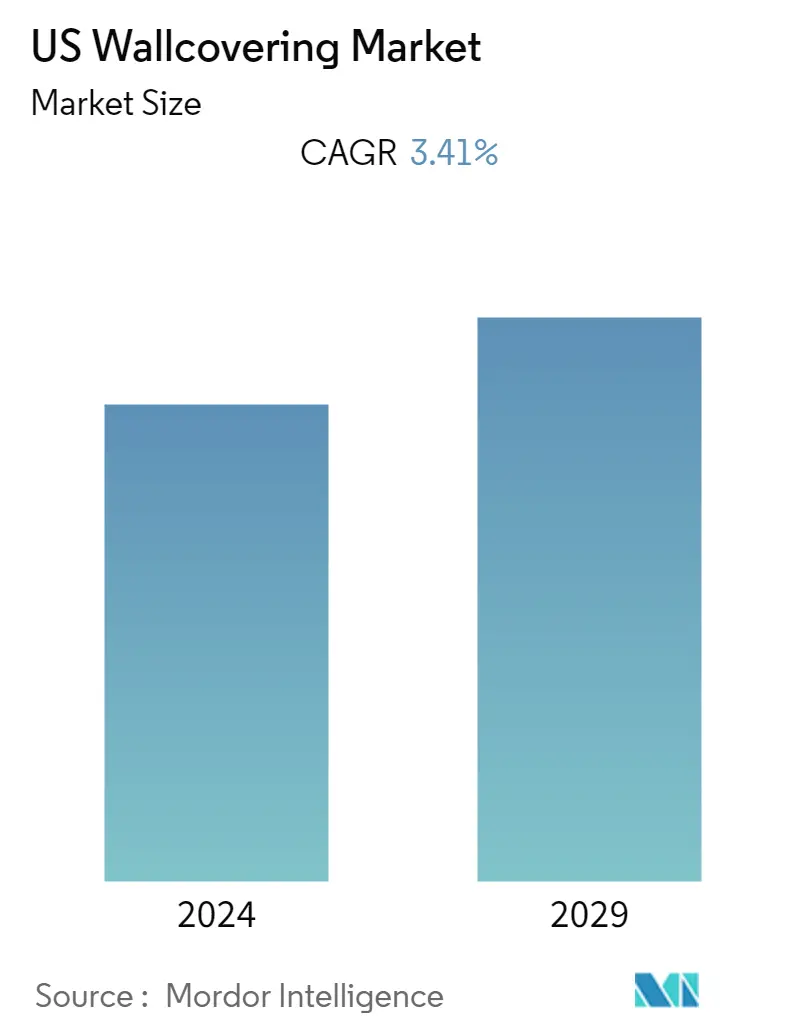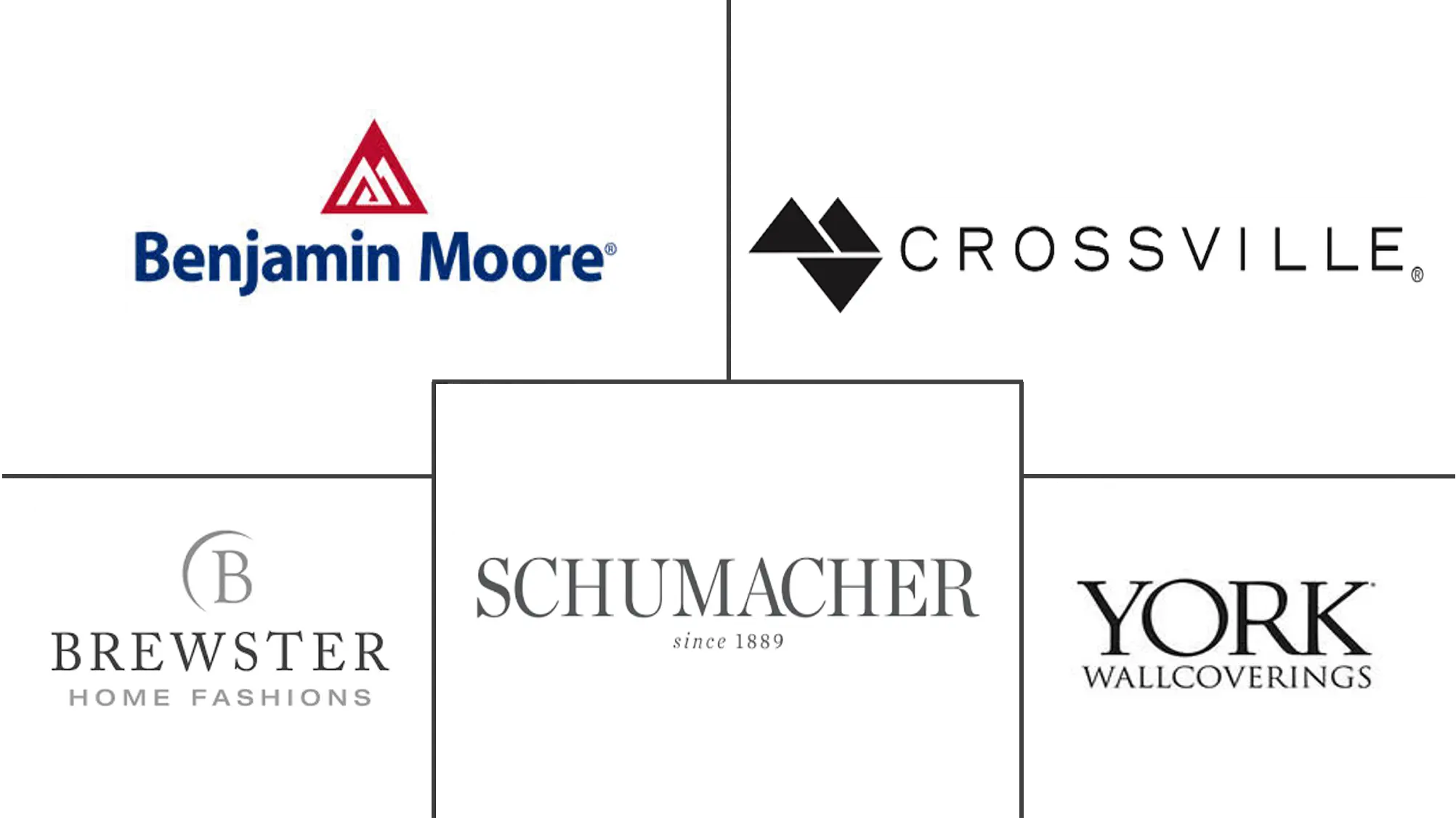Market Size of US Wallcovering Industry

| Study Period | 2019 - 2029 |
| Base Year For Estimation | 2023 |
| Forecast Data Period | 2024 - 2029 |
| Historical Data Period | 2019 - 2022 |
| CAGR | 3.41 % |
Major Players
*Disclaimer: Major Players sorted in no particular order |
US Wallcovering Market Analysis
The US Wallcovering Market was valued at USD 5.41 billion in 2020, and it is expected to reach USD 6.58 billion by 2026, registering a CAGR of 3.41% during the forecast period (2021-2026). Gains in the US Wallcovering Market be driven by a recovery in construction activity, especially in the residential sector of the region. Demand for wall coverings has also benefitted from the turnaround in the prospects for wallpaper, which has suffered from negative consumer perceptions and stiff competition from paint and coatings. The region's increasing disposable income and rapid rise in urbanization have resulted in the increasing usage of wall coverings, along with other modern products, such as window frames with very low heat transmission, electrical cables and conduits, easily cleaned flooring, and light-reflecting roofing. Marketing environmental factors such as interest rates, new housing, and commercial construction statistics, homeowner remodeling, and repair spending have also been driving the market.
- Residential constructions account for a meaningful market share in the wallcovering market and are anticipated to behold a notable growth rate. The employment possibilities and population growth are key drivers of the increasing demand for new housing as continued population growth across the United States have led to increased demand for all dwellings, including apartments.
- Wall panel products will be the fastest-growing wall coverings type through 2020. Sales of wall panel products will profit from the constant recovery in residential construction activity, coupled with growth prospects in nonresidential construction markets. Laminate panels, specifically sheet panels, will continue to dominate demand, but more attractive growth prospects will emerge for many products at opposite ends of the value spectrum.
- Paint is considered a better alternative, as compared to wall coverings in specific uses. Furthermore, removing existing wallpaper can be a tiresome task that needs the right tools to be efficient. Stripping wallpaper can be achieved with chemicals or stripping tools, but care must be taken, or the wall can be damage.
- As the effects of COVID-19 are perceived around the world, real estate firms in the United States are being affected in different ways, mostly dependent on region and asset class. In the near-term, real estate administrators in the country are worried about preserving value and liquidity, keeping residents and visitors safe, including enhanced cleaning measures, and complying with administrative agency requirements.
- According to a new study from the National Association of Home Builders, the US housing industry stands poised to lead the economic rebound once social distancing and other COVID-19 mitigation efforts show success in containing the coronavirus pandemic. As the housing sector has customers for the wallcovering market, the COVID-19 pandemic might impact the market being studied in the long run.
US Wallcovering Industry Segmentation
Wallcoverings protect the wall surface from accidental marks or scratches, besides imparting an air of quality and grandeur to uncovered walls. They further help in neutralizing the interior and customizing it with the help of various colors and patterns. Also, these coverings are cost-effective. The two common areas of applications of wallcoverings include residential and commercial. Residential wall coverings are mainly used in homes and small businesses to add attractiveness to rooms and express an individual style.
| By Type | |||||||
| Wall Panel | |||||||
| Tiles | |||||||
| Metal Wall | |||||||
|
| By Application | |
| Residential | |
| Commercial |
| By End User | |
| Specialty Store | |
| Home Center | |
| Furniture Store | |
| Mass Merchandizer | |
| E-commerce | |
| Other End Users |
US Wallcovering Market Size Summary
The US wallcovering market is poised for growth, driven by a resurgence in construction activities, particularly in the residential sector. This recovery is bolstered by increasing disposable incomes and rapid urbanization, which have led to a higher demand for modern home products, including wall coverings. The market is experiencing a shift in consumer preferences, with wallpaper gaining traction despite previous competition from paint and coatings. This change is supported by innovations in wallpaper technology, such as the use of non-woven backing and breathable fabrics, which enhance usability and address previous limitations. The residential construction segment is expected to maintain a significant market share, fueled by population growth and the resulting demand for new housing.
The market landscape is moderately competitive, with several major players dominating the scene. These companies are actively expanding their global presence through strategic collaborations and acquisitions, aiming to enhance their product offerings and increase market share. The wallcovering market is also witnessing a trend towards environmentally friendly products, which align with sustainable development goals and improve consumer perception. As the housing market shows signs of recovery, supported by favorable interest rates and increased building permits, the demand for wallcoverings is expected to rise, benefiting both residential and non-residential construction sectors.
US Wallcovering Market Size - Table of Contents
-
1. MARKET DYNAMICS
-
1.1 Market Overview
-
1.2 Introduction to Market Drivers and Restraints
-
1.3 Market Drivers
-
1.3.1 Rebounding Residential Construction Activity
-
1.3.2 Recovery in Wall Panel Sales Aided by Higher Awareness
-
1.3.3 Increasing Demand for Digitally Printed Solutions
-
1.3.4 Growth in Non-woven and Paper-based Wallpapers
-
-
1.4 Market Restraints
-
1.4.1 Strong Competition from the Paints Segment
-
1.4.2 Recent Changes in Macro-environment Expected to Impact Customer Spending
-
-
1.5 Industry Value Chain Analysis
-
1.6 Industry Attractiveness - Porter's Five Force Analysis
-
1.6.1 Threat of New Entrants
-
1.6.2 Bargaining Power of Buyers/Consumers
-
1.6.3 Bargaining Power of Suppliers
-
1.6.4 Threat of Substitute Products
-
1.6.5 Intensity of Competitive Rivalry
-
-
1.7 Import-Export Analysis for Wallcoverings and Wallpapers
-
1.8 Customer Spending Trends on Wallcoverings and Other Key Alternatives in the United States
-
1.9 Impact of COVID-19 on the Wallcoverings Industry
-
1.10 Key Product Innovations
-
1.10.1 Eco-Friendly Wallcoverings
-
1.10.2 Plank Prints
-
1.10.3 Digital Printing advancements
-
1.10.4 Light Absorbing Wallcoverings
-
-
-
2. MARKET SEGMENTATION
-
2.1 By Type
-
2.1.1 Wall Panel
-
2.1.2 Tiles
-
2.1.3 Metal Wall
-
2.1.4 Wallpaper
-
2.1.4.1 Vinyl
-
2.1.4.2 Non-woven Wallpaper
-
2.1.4.3 Paper-based Wallpaper
-
2.1.4.4 Fabric Wallpapers
-
2.1.4.5 Other Wallpaper Types
-
-
-
2.2 By Application
-
2.2.1 Residential
-
2.2.2 Commercial
-
-
2.3 By End User
-
2.3.1 Specialty Store
-
2.3.2 Home Center
-
2.3.3 Furniture Store
-
2.3.4 Mass Merchandizer
-
2.3.5 E-commerce
-
2.3.6 Other End Users
-
-
US Wallcovering Market Size FAQs
What is the current US Wallcovering Market size?
The US Wallcovering Market is projected to register a CAGR of 3.41% during the forecast period (2024-2029)
Who are the key players in US Wallcovering Market?
Brewster Home Fashion , Benjamin Moore & Co, York Wall Coverings, F. Schumacher & Co. and Crossville Inc. are the major companies operating in the US Wallcovering Market.

